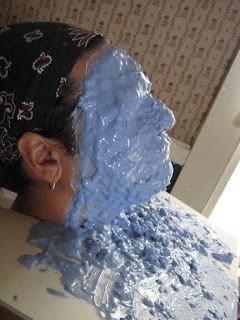In honor of Halloween, I'd like to share the process I went through in
making myself a zombie costume.
This post is going to be picture-heavy, as I
took a bunch of snaps while I was making this costume, but the pics should be helpful in showing the steps in my process.
I had something pretty specific in mind for my zombie costume: I wanted to have an exposed jaw, as if the outer skin had been ripped right off of it.
It was going to be a lot of work. But that didn't really matter; I was just really excited to be making a zombie costume from scratch. I mean—really—who doesn't like making a zombie costume, right?
OK, let's do this!
First, I prepared everything that I would need to make the mold of my face. The primary molding material I used for this is called alginate. It's a soft molding material that picks up a lot of detail. Dentists use it to make molds of your teeth. I would also need plaster bandages to make an outer support structure for the mold and some baby oil to lubricate my eyebrows, so that they don't stick to the mold (Vaseline would also work).
As it was my own face that was getting molded, I wouldn't actually be able to do this part of the mold making. So I called in a crackerjack, impromptu moldmaker: my wife, Adrienne. It was the first time my wife had ever worked with alginate, but she picked it up pretty quick. And as expected, she did great!
Alginate starts off as a powder. You mix it with water, and it makes a creamy paste, kinda like lumpy pancake batter or thick yogurt. While it's wet, you quickly cover the part you'd like to mold. But you do have to move quick because this material has a very short working-time. And when your working time is over, you'll know it; because all at once, it will harden up and become a solid.
After the alginate set up, Adrienne moved to the next step: making a mother-mold out of plaster bandages. The mother-mold acts as a cradle for the alginate, and it will help the alginate maintain its original shape after it's released from my face. Now around this time, it might be important to point out that we left breathing holes around my nostrils. That's so that I wouldn't suffocate. Luckily, they worked.
And then, after the plaster bandages fully harden....Once the alginate mold is off, it gets placed back into the mother-mold to help it keep its original shape. My plan is to create a solid plaster casting out of this mold by pouring plaster directly into it, so it's best if there are no holes for the plaster to leak from. The only holes in this mold are the breathing holes around my nostrils, so I simply plug them up with some clay.
After brushing in the "splash-coat," I'm ready to pour in the rest of my plaster. I pour it up to the very top rim of the mold.
Then I let the plaster set (or harden up).
And once the plaster is set, I release it from the alginate. And...
Voilà! I have a casting of my face.
You'll note that the area around the nostrils is distorted or incomplete. This is due to the clay in the breathing holes. But for this costume, that won't be a problem. The only part that's important to keep intact is the jaw area, and that came out just fine.
Next up was the sculpting—and I jumped right into this part. I used WED clay (a water and mineral oil based clay), and that helped things move along very quickly.
The sculpt was really fun to do. I used a few reference images (mostly pictures of skulls) to help me with the anatomical features.
In the end, though, I wanted this sculpt to look somewhat comical (it's just funner that way), so I tried to exaggerate the look of the whole thing by slightly increasing the scale of all the main features: jawbone, chin, and teeth.
And in terms of being practical, I tried to leave a little room around my mouth so that I'd be able to eat and drink.
And after the sculpture of my zombie jaw was finished, it was time to make another mold.
I added release to any exposed plaster around my sculpture, put up some clay walls, and mixed my plaster (Ultracal 30). And very soon after that, I had a mold of my sculpture.
And now that I had my final work mold finished, I was ready to brush in rubber latex and make the casting for my zombie jaw.
I wound up making two castings. I didn't document this part of the process, but all it involved was brushing in several layers of latex (drying each layer with a hair-dryer) until I was able to build a thickness that was strong enough to hold its shape. After you pull your rubber casting out of the mold, it's ready to paint. Below is a side-by-side picture of the two castings I made: the one on the left is raw and unpainted, but the one on the right has its paint job already in progress.
Painting rubber latex is not as easy as you'd think. It can actually be a bit tricky. The best thing (that I know) to do is to make your own paint. I did this by getting some clear rubber latex and adding my own tints to make the colors of paint that I needed. Once I had my colors, I started using my custom-made paints on the rubber latex mask. Rubber latex bonds to itself, so as you paint on each new layer, the new color bonds right along with it.
I've never considered myself much of a painter, but for this costume, I already had a general idea of what I wanted to see. So I just went for it, experimenting and having fun as I went along.
Here's one trick I learned: if you water down your latex paint, you can use it as a wash (kinda like watercolors), which was great for adding darker tones into cracks and crevices.
I wanted some "bone" to be visible, so I went back into it with some brighter off-white tones around the chin and along the lower jaw. And as a final detail, I added some chunky red pieces of rubber latex to act as fleshy bits of meat that were still stuck to my jaw.
Finally, it was finished! And as soon as it was ready, I had to do a quick trial run to see how it looked. I grabbed my makeup kit and a pair of contact lenses that I had bought especially for this costume. And in no time, I got the first glimpse of what my zombie costume would look like. I gotta say, the contact lenses totally sold it!
The trial run was a success! And now I couldn't wait to get the rest of the costume finished. Now, let me see, what...is...missing? Oh yeah, blood! Lots, and lots, of blood!
And after blooding things up a bit and doing a full blown zombie makeup job (again, thanks to my artistic wife, Adrienne), there you have it—I am undead; I am rotting flesh and jawbone; I am a zombie!
Aw, yeah! I was totally happy with how my zombie costume turned out. It's one of the best costumes that I've ever made, and it's probably one of my all-time favorites, too. I liked it so much that I wound up wearing it twice that year (2009). Once to a Halloween costume contest (which I sadly did not win). The pictures (above and below) show the zombie makeup I wore to that costume party.
Below is a picture of me going home on BART after that costume party. (For some reason, nobody wanted to take the seat next to me.)
And finally, the other occasion I dressed up in my zombie costume was to celebrate my own 40th birthday. That's right; I had a zombie party to celebrate 40 years of being undead!
Above is a picture of my wife and me from our Zombie Party. If you'd like to see more on that, check this out: Zombie Party!
And who made my wife's awesome zombie costume (hanging guts and all) you might ask?
You guessed it—She did!
Happy Halloween, friends!
~Tony Preciado




















































